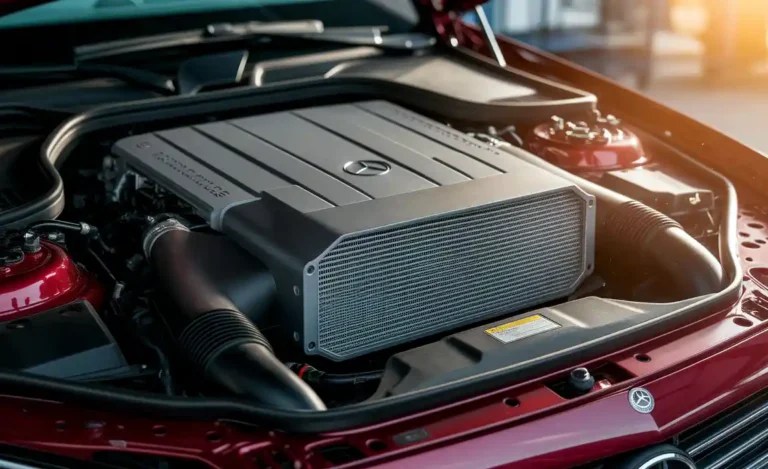B Class All Wheel Drive: Ultimate Performance
For many drivers, the B-Class All-Wheel Drive system, particularly Mercedes-Benz’s 4MATIC, offers a significant boost in traction, stability, and overall confidence, especially in challenging weather conditions. It enhances performance by intelligently distributing power to all four wheels as needed, ensuring a safer and more dynamic driving experience.

Driving a Mercedes-Benz B-Class feels special. It’s a versatile vehicle, perfect for city commutes, family outings, or weekend adventures. For those who crave an extra layer of security and driving enjoyment, especially when the weather turns, the B-Class equipped with All-Wheel Drive (AWD) is a game-changer. Many drivers wonder if AWD in a compact luxury vehicle like the B-Class truly makes a difference. The answer is a resounding yes. This advanced system is designed to actively manage power distribution, adapting to various driving surfaces and situations to keep you firmly in control. We’ll explore how this technology works and why it enhances the B-Class’s already impressive capabilities.
What is All-Wheel Drive (AWD)?
All-Wheel Drive, often abbreviated as AWD, is a drivetrain system that can deliver engine power to all four wheels of a vehicle. Unlike traditional two-wheel-drive systems (front-wheel drive or rear-wheel drive), AWD offers improved traction and stability by utilizing all wheels for propulsion. This is particularly beneficial in situations where grip is limited, such as on wet roads, snow, ice, or gravel.
The primary goal of an AWD system is to automatically or manually adjust the power sent to each wheel to maximize grip. When sensors detect that one or more wheels are slipping, the system can rapidly redirect power to the wheels that still have traction. This intelligent distribution helps prevent wheel spin and keeps the vehicle moving forward smoothly and safely.
How AWD Works in the Mercedes-Benz B-Class
Mercedes-Benz integrates its sophisticated 4MATIC all-wheel drive system into certain B-Class models, elevating their driving dynamics. The 4MATIC system in the B-Class is primarily a front-biased system, meaning it usually sends more power to the front wheels during normal driving conditions. However, it’s far from static. When the system detects a need for more grip, it instantaneously and seamlessly transfers torque to the rear wheels.

Here’s a simplified look at how it operates:
- Sensors: Various sensors constantly monitor wheel speed, steering angle, throttle position, and lateral acceleration.
- Electronic Control Unit (ECU): The data from these sensors is fed to a central ECU, which is the brain of the 4MATIC system.
- Torque Distribution: Based on the sensor data, the ECU precisely controls an electronically managed multi-plate clutch located in the transfer case. This clutch can engage or disengage to distribute power between the front and rear axles.
- On-Demand Power: In most situations, the system operates unobtrusively, ensuring optimal traction without the driver needing to intervene. If the front wheels start to lose grip, for example, the ECU can quickly send more power to the rear wheels.
This intelligent, on-demand power distribution is what makes 4MATIC so effective. It provides the security of AWD when you need it most, without compromising fuel efficiency or the car’s agile feel during everyday driving. For a deeper dive into the engineering behind Mercedes-Benz’s AWD, you can explore resources from reputable automotive engineering sites, such as SAE International, which publishes extensive research on drivetrain technologies.
Benefits of B-Class All-Wheel Drive
Opting for a B-Class with AWD brings a host of advantages that can significantly enhance your driving experience. These benefits extend beyond just handling rough weather, contributing to the vehicle’s overall performance and your peace of mind.

Enhanced Traction and Stability
The most immediate benefit of AWD is superior traction. By distributing power across all four wheels, the system dramatically reduces the chance of wheel spin, especially when accelerating from a standstill or navigating slippery surfaces. This translates to increased stability, making your B-Class feel more planted and secure on the road.
Improved Handling in Various Conditions
Whether you’re facing rain-slicked city streets, dusty country lanes, or snowy mountain passes, AWD adapts. It constantly seeks optimal grip, allowing for more confident cornering and predictable behavior even when road conditions are less than ideal. This improved handling can make a noticeable difference in how safe and enjoyable your drive is.
Increased Driving Confidence
Knowing that your vehicle is equipped to handle a wider range of conditions can profoundly boost driving confidence. You’ll feel more at ease venturing out on a cold winter morning or taking a spontaneous road trip, less concerned about unpredictable weather impacting your journey.
Better Resale Value
Vehicles equipped with desirable features like AWD often hold their value better. For a luxury compact vehicle like the B-Class, AWD is a premium option that can appeal to a broader range of buyers, potentially leading to a higher resale price.
Performance in Performance Driving
While the B-Class isn’t an AMG model, the AWD system can still enhance its performance driving characteristics. It allows for more effective application of power, especially when accelerating out of corners, contributing to a more dynamic and engaging driving feel.
B-Class AWD Models and Configurations
Mercedes-Benz offers the 4MATIC all-wheel drive system on various iterations of the B-Class. It’s important to note that availability can vary by model year, region, and specific trim level. Typically, you’ll find 4MATIC offered on higher-spec B-Class models, often denoted by a ‘4MATIC’ badge on the tailgate.

Some common B-Class models where AWD has been available include:
- B 250 4MATIC: This has often been a popular choice, combining a potent engine with the enhanced traction of all-wheel drive.
- B 200 d 4MATIC: For diesel enthusiasts, a 4MATIC version of the B 200 d might be available, offering excellent fuel economy paired with AWD capability.
- Specific AMG Line Trims: While not full AMG models, performance-oriented AMG Line packages might also be paired with the 4MATIC system.
When looking at used models or comparing new vehicles, always verify the specific drivetrain configuration. You can typically find this information on the window sticker, in the owner’s manual, or by checking the vehicle’s VIN. The Mercedes-Benz official website or a Mercedes-Benz dealership can provide definitive details for current and past model years.
Comparing AWD to Other Drivetrains for the B-Class
When considering a B-Class, you’ll likely encounter options with Front-Wheel Drive (FWD) and potentially Rear-Wheel Drive (RWD) in some configurations, though FWD is more common for the bulk of B-Class models. Understanding the differences will help you choose the best fit for your needs.

Here’s a straightforward comparison:
| Feature | Front-Wheel Drive (FWD) | Rear-Wheel Drive (RWD) | All-Wheel Drive (AWD) |
|---|---|---|---|
| Power Distribution | Engine power sent only to the front wheels. | Engine power sent only to the rear wheels. | Engine power can be sent to all four wheels. |
| Traction in Poor Conditions | Moderate; can struggle on slippery surfaces when accelerating uphill. | Can be excellent in snow/ice if balanced, but prone to oversteer. Less ideal for initial acceleration grip. | Excellent; maximizes grip by sending power to wheels with traction. |
| Handling Dynamics | Tendency towards understeer (front tires lose grip first) when pushed. | Often preferred for sporty handling; prone to oversteer (rear tires lose grip first). | Generally neutral, can feel very stable and secure, though can be slightly heavier. |
| Fuel Efficiency | Generally the most fuel-efficient due to less weight and drivetrain resistance. | Typically slightly less efficient than FWD. | Often the least fuel-efficient due to added weight and drivetrain components. |
| Complexity & Cost | Simplest and least expensive to manufacture and maintain. | More complex than FWD, can be more costly. | Most complex and expensive to manufacture and maintain. |
| Best For | Everyday driving, good fuel economy, mild climates. | Sporty driving feel, rear-biased performance. | All-weather capability, security, dynamic performance in varied conditions. |
For the Mercedes-Benz B-Class, the choice often comes down to how you’ll use the vehicle. If you live in an area with frequent harsh weather or prioritize maximum stability and security, the 4MATIC AWD system is a compelling upgrade. If you primarily drive in mild climates and prioritize fuel economy and lower purchase cost, FWD might suffice.
Optimizing Performance with AWD
While the AWD system itself is designed to enhance performance and safety, there are ways to maximize its benefits and ensure your B-Class continues to perform at its best.
Tire Choice is Crucial
Your tires are the only contact point between your vehicle and the road. For AWD vehicles, especially those intended for varied conditions, tire choice is paramount. All-season tires are a good compromise for many drivers, offering decent performance in dry, wet, and light snow conditions. If you regularly encounter heavy snow or ice, consider a set of dedicated winter tires.
For optimal performance, look for tires with robust tread patterns designed for grip and water/slush evacuation. Always ensure your tires are the correct size and type specified by Mercedes-Benz for your B-Class model. According to tire safety guidelines from organizations like the National Highway Traffic Safety Administration (NHTSA), proper tire selection and maintenance are key to vehicle safety and performance.
Regular Maintenance
The AWD system, like any sophisticated mechanical system, requires regular maintenance. While it’s largely self-monitoring, attention should be paid to:
- Differential and Transfer Case Fluid: These components may have fluid that needs to be checked and replaced at recommended service intervals. Consult your owner’s manual for specific recommendations for your B-Class 4MATIC.
- Tire Rotation: AWD systems can sometimes cause tires to wear unevenly if not rotated regularly. Following a consistent tire rotation schedule (e.g., every 5,000-7,500 miles) will help ensure even wear and prolong tire life.
- Alignment: Proper wheel alignment ensures that your tires are tracking straight and true, which is crucial for AWD performance and tire longevity.
Driving Techniques
Even with AWD, safe driving practices are essential. Understand how your AWD system behaves:
- Smooth Inputs: While AWD offers more grip, avoid abrupt acceleration, braking, or steering, especially on slippery surfaces. Smooth, deliberate inputs will allow the system to work most effectively.
- Gradual Braking: AWD does not improve braking distances significantly compared to a two-wheel-drive vehicle. Brake earlier and more gently when traction is reduced.
- Know Your Limits: AWD provides a safety net, not a license to drive recklessly. Always drive at a speed appropriate for the conditions.
Understanding Potential AWD Issues and Troubleshooting
While the 4MATIC system in the B-Class is engineered for reliability, like any complex automotive technology, it can occasionally encounter issues. Early detection and understanding can save you time and money.
Common Signs of AWD Problems
Pay attention to any changes in your vehicle’s behavior. Some common indicators of an AWD issue include:
- Warning Lights: The most obvious sign is an illuminated AWD warning light on your dashboard. This could indicate a fault in the system that requires immediate attention.
- Clunking or Grinding Noises: Unusual noises when accelerating, turning, or braking can point to problems with the differentials, transfer case, or drive shafts.
- Vibrations: A persistent vibration felt through the steering wheel or floor, especially during acceleration or at certain speeds, might suggest an issue with the drivetrain components.
- Vehicle Pulling to One Side: While often an alignment issue, if the pulling is accompanied by other symptoms, it could relate to uneven power distribution from the AWD system.
- Stiff Steering: In some cases, problems with the AWD system can put extra strain on the steering components, leading to a stiffer steering feel.
Basic Troubleshooting Steps
If you suspect an AWD issue, here are some initial steps:
- Check the Owner’s Manual: Your B-Class owner’s manual is an invaluable resource. It will detail what specific warning lights mean and provide basic troubleshooting advice for common issues.
- Inspect Tires: Ensure all tires are properly inflated and have even wear. Uneven tire wear or pressure can sometimes mimic AWD problems.
- Note the Conditions: Try to remember when the problem first occurred. Was it during specific driving conditions (e.g., turning, accelerating, on a bumpy road)? This information will be crucial for a mechanic.
When to Seek Professional Help:
For most AWD-related concerns, especially those involving mechanical noises or dashboard warning lights, it’s best to consult a qualified Mercedes-Benz technician or a specialized repair shop. Attempting complex repairs without the proper knowledge and tools can lead to further damage or safety hazards. Information on advanced diagnostics for Mercedes-Benz vehicles can often be found on forums dedicated to the brand, but always rely on professional service for actual repairs.
Frequently Asked Questions About B-Class AWD
Q1: Is AWD standard on all B-Class models?
No, AWD is typically an optional feature on many B-Class models, usually offered as Mercedes-Benz’s 4MATIC system. It’s often found on higher trim levels or as part of option packages. Always check the specific vehicle’s configuration to confirm if it has AWD.
Q2: Does AWD in the B-Class improve fuel economy?
Generally, AWD systems add weight and drivetrain complexity, which can lead to slightly lower fuel economy compared to a front-wheel-drive version of the same car. However, Mercedes-Benz’s 4MATIC systems are designed to be efficient, distributing power only when needed, minimizing the impact on fuel consumption during normal driving.
Q3: Is 4MATIC AWD better than other AWD systems?
Mercedes-Benz’s 4MATIC is considered a sophisticated and highly effective AWD system, known for its seamless operation and integration with the vehicle’s other electronic systems. While “better” is subjective and depends on specific needs, 4MATIC is a premium offering that consistently performs well in providing traction and stability.
Q4: Can I drive my B-Class AWD in snow?
Yes, the B-Class with 4MATIC AWD is designed to significantly improve driving capability in snowy and icy conditions by providing better traction. However, AWD does not negate the laws of physics. Always drive cautiously, reduce speed, and use appropriate tires (like winter tires) for the best performance and safety in snow and ice.
Q5: Does AWD affect the B-Class handling characteristics?
AWD, particularly the 4MATIC system, generally enhances handling stability by improving traction, especially during acceleration and cornering on slippery surfaces. It can contribute to a more neutral and secure handling feel. Some drivers might notice a slight increase in vehicle weight, but the added grip usually outweighs this for most drivers.






